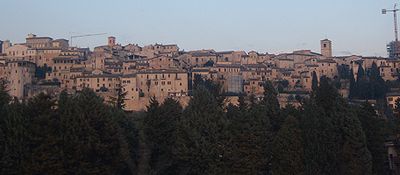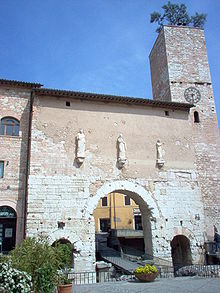
Spello
Encyclopedia
Spello is an ancient town and comune (township) of Italy
, in the province of Perugia
in east central Umbria
, on the lower southern flank of Mt. Subasio
. It is 6 km (4 mi) NNW of Foligno
and 10 km (6 mi) SSE of Assisi
.
The old walled town lies on a regularly NW-SE sloping ridge that eventually meets the plain. From the top of the ridge, Spello commands a good view of the Umbrian plain towards Perugia
; at the bottom of the ridge, the town spills out of its walls into a small modern section (or Borgo) served by the rail line from Rome
to Florence
via Perugia.


, it became a Roman colony in the 1st century BC. Under the reign of Constantine the Great it was called Flavia Constans, as attested by a document preserved in the local Communal Palace.
Other points of interest include:
In the plain, near S. Claudio, are the remains of a semi-excavated Roman amphitheater; and a small valley to the east of the town is remarkable for its traces of Roman centuriation.
Beyond the town proper, the comunes chief monuments are the church of San Silvestro at Collepino, and the church of the Madonna della Spella with late-medieval votive frescoes and graffiti.
, Italy, since 1974
Since 2008 Spello has also a pact of friendship with Accadia
, Italy.
Italy
Italy , officially the Italian Republic languages]] under the European Charter for Regional or Minority Languages. In each of these, Italy's official name is as follows:;;;;;;;;), is a unitary parliamentary republic in South-Central Europe. To the north it borders France, Switzerland, Austria and...
, in the province of Perugia
Province of Perugia
The Province of Perugia is the larger of the two provinces in the Umbria region of Italy, comprising two-thirds of both the area and population of the region. Its capital is the city of Perugia...
in east central Umbria
Umbria
Umbria is a region of modern central Italy. It is one of the smallest Italian regions and the only peninsular region that is landlocked.Its capital is Perugia.Assisi and Norcia are historical towns associated with St. Francis of Assisi, and St...
, on the lower southern flank of Mt. Subasio
Monte Subasio
Mount Subasio is a mountain of the Apennine mountains, in the province of Perugia, Umbria, central Italy. On its slopes are located the ancient towns of Assisi and Spello.The mountain stands about 1290 metres above sea level....
. It is 6 km (4 mi) NNW of Foligno
Foligno
Foligno is an ancient town of Italy in the province of Perugia in east central Umbria, on the Topino river where it leaves the Apennines and enters the wide plain of the Clitunno river system...
and 10 km (6 mi) SSE of Assisi
Assisi
- Churches :* The Basilica of San Francesco d'Assisi is a World Heritage Site. The Franciscan monastery, il Sacro Convento, and the lower and upper church of St Francis were begun immediately after his canonization in 1228, and completed in 1253...
.
The old walled town lies on a regularly NW-SE sloping ridge that eventually meets the plain. From the top of the ridge, Spello commands a good view of the Umbrian plain towards Perugia
Perugia
Perugia is the capital city of the region of Umbria in central Italy, near the River Tiber, and the capital of the province of Perugia. The city is located about north of Rome. It covers a high hilltop and part of the valleys around the area....
; at the bottom of the ridge, the town spills out of its walls into a small modern section (or Borgo) served by the rail line from Rome
Rome
Rome is the capital of Italy and the country's largest and most populated city and comune, with over 2.7 million residents in . The city is located in the central-western portion of the Italian Peninsula, on the Tiber River within the Lazio region of Italy.Rome's history spans two and a half...
to Florence
Florence
Florence is the capital city of the Italian region of Tuscany and of the province of Florence. It is the most populous city in Tuscany, with approximately 370,000 inhabitants, expanding to over 1.5 million in the metropolitan area....
via Perugia.


History
Populated in ancient times by the UmbriUmbri
The Umbri were an Italic people of ancient Italy. A region called Umbria still exists and is currently occupied by Italian speakers. It is somewhat smaller than the ancient Umbria....
, it became a Roman colony in the 1st century BC. Under the reign of Constantine the Great it was called Flavia Constans, as attested by a document preserved in the local Communal Palace.
Main sights
The densely-inhabited town, built of stone, is of decidedly medieval aspect, and is enclosed in a circuit of medieval walls on Roman foundations, including three Roman Late Antique gates (Porta Consolare, Porta di Venere and the "Arch of Augustus") and traces of three more, remains of an amphitheater, as well several medieval gates. Spello boasts about two dozen small churches, most of them medieval: the most important are:- Santa Maria Maggiore (known from 1159), probably built over an ancient temple dedicated to JunoJuno (mythology)Juno is an ancient Roman goddess, the protector and special counselor of the state. She is a daughter of Saturn and sister of the chief god Jupiter and the mother of Mars and Vulcan. Juno also looked after the women of Rome. Her Greek equivalent is Hera...
and VestaVesta (mythology)Vesta was the virgin goddess of the hearth, home, and family in Roman religion. Vesta's presence was symbolized by the sacred fire that burned at her hearth and temples...
. The façade has a Romanesque portal and a 13th century bell tower, while the pilasters next to the apse have frescoes by Perugino (1512). The most striking feature is the Baglioni ChapelBaglioni ChapelThe Baglioni Chapel is a chapel in the Collegiate church of Santa Maria Maggiore, Spello, central Italy. It is known for its Renaissance frescoes executed by Pinturicchio from c. 1500 to 1501.-History:...
, frescoed by PinturicchioPinturicchioBernardino di Betto, called Pintoricchio or Pinturicchio was an Italian painter of the Renaissance. He acquired his nickname, Pintoricchio , because of his small stature, and he used it to sign some of his works....
. The Umbrian artist was called to paint it around 1500 by Troilo Baglioni, after he had just finished the Borgia ApartmentBorgia ApartmentThe Borgia Apartment is a suite of rooms in the Apostolic Palace in the Vatican.-History:The Borgia Apartment was adapted for personal use by Pope Alexander VI ....
's decoration. The cycle include the Annunciation, the Nativity and the Dispute with the Doctors, plus four Sibyls in the vault. The Palazzo dei Canonici, annexed to the church, houses the Town's Art Gallery. - Sant'Andrea (known from 1025). The interior, on a single nave, has 14th century frescoes. There's also a panel by Pinturicchio.
- San Lorenzo (12th century). San Bernardino da Siena began his preaching season in this church in 1438.
- San Claudio (11th century or earlier), an elegant example of Romanesque architectureRomanesque architectureRomanesque architecture is an architectural style of Medieval Europe characterised by semi-circular arches. There is no consensus for the beginning date of the Romanesque architecture, with proposals ranging from the 6th to the 10th century. It developed in the 12th century into the Gothic style,...
with a rose window on the asymmetrical façade. The interior has 14th century votive frescoes from the Umbrian school. It is said to have been built on the remains of a Paleo-Christian cemetery. - Tega Chapel (14th century), with Umbrian school 15th century frescoes, including a Crucifixion attributed to Nicolò Alunno.
Other points of interest include:
- Palazzo Comunale Vecchio ("Old Town Hall", built in 1270 and enlarged after the end of the Baglioni seigniory, in 1567-1575). It has some frescoed halls, one attributed to the ZuccariZuccariZuccari or Zuccaro may refer to:* the surname of a family of notable Italian painters living in the 16th century:** Ottaviano Zuccari and his sons** Taddeo Zuccari and** Federico Zuccari...
brothers. It is faced by a 16th century fountain. - Palazzo Cruciali, built in the early 17th century.
- Palazzo Baglioni, erected as a fortificated mansion around 1359. The Governor's Hall has frescoes from the 16th century.
- Arch of Augustus (1st century BC-1st century AD).
In the plain, near S. Claudio, are the remains of a semi-excavated Roman amphitheater; and a small valley to the east of the town is remarkable for its traces of Roman centuriation.
Beyond the town proper, the comunes chief monuments are the church of San Silvestro at Collepino, and the church of the Madonna della Spella with late-medieval votive frescoes and graffiti.
Festivals
- The Infiorata includes a whole night of work to create a flowers for the Corpus Domini feast.
Twin towns
AlfonsineAlfonsine
Alfonsine is a comune in the Province of Ravenna in the Italian region Emilia-Romagna, located about 60 km east of Bologna and about 15 km northwest of Ravenna....
, Italy, since 1974
Since 2008 Spello has also a pact of friendship with Accadia
Accadia
Accadia is a town and comune in the province of Foggia in the Apulia region of southeast Italy. Until the mid-20th century it was just within the eastern frontier of the region of Campania in the province of Avellino....
, Italy.
External links
- Official site
- Bill Thayer's site (including Urbini's Spello, Bevagna, Montefalco)
- Creative Spello by Adalberto Tiburzi

